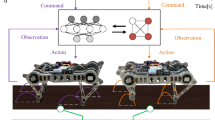Abstract
This paper presents a method we have called the Sequential Method of Analytical Potential (SMAP). By taking account of a system’s actual capabilities via Dynamic Propulsion Potentials (DPP), this method aims to generate dynamic walking gaits for bipedal robots. The objective is to move the robot by acting directly on the actuator forces. The various accelerations governing the movements of the robot are controlled by direct, precise modification of its own dynamic effects, taking account of the robot’s intrinsic dynamics as well as the capabilities of the actuators moving the joints.
Similar content being viewed by others
References
Hirai, K., Hirose, M., Haikawa, Y., Takenaka, T.: The development of Honda humanoid robot. In: IEEE International Conference on Robotics and Automation (ICRA), May, Leuven, Belgium, pp. 1321–1326 (1998)
Hirai, K.: Current and future perspective of Honda humanoid robot. In: IEEE International Conference on Intelligent Robots and Systems (IROS), September, Grenoble, France, pp. 500–508 (1997)
Sakagami, Y., Watanabe, R., Aoyama, C., Matsunaga, S., Higaki, N., Fujimura, K.: The intelligent ASIMO: system overview and integration. In: IEEE International Conference on Intelligent Robots and Systems (IROS), October, Lausanne, Suisse, pp. 2478–2483 (2002)
Kaneko, K., Kanehiro, F., Kajita, S., Yokoyama, K., Akachi, K., Kawasaki, T., Ota, S., Isozumi, T.: Design of prototype humanoid robotics plateform for HRP. In: IEEE International Conference on Intelligent Robots and Systems (IROS), September, Victoria, Canada, pp. 2431–2436 (1998)
Kaneko, K., Kanehiro, F., Kajita, S.: Humanoid robot HRP-2. In: IEEE International Conference on Robotics and Automation (ICRA), April, New Orleans, USA, pp. 1083–1090 (2004)
Kajita, S., Kaneko, K., Morisawa, M., Nakaoka, S., Hirukawa, H.: ZMP-based biped running enhanced by toe springs. In: IEEE International Conference on Robotics and Automation (ICRA), April, Rome, Italy, pp. 3963–3969 (2007)
Morisawa, M., Harada, K., Kajita, S., Nakaoka, S., Fujiwara, K., Kanehiro, F., Kaneko, K., Hirukawa, H.: Experimentation of humanoid walking allowing immediate modification of foot place based on analytical solution. In: IEEE International Conference on Robotics and Automation (ICRA), April, Rome, Italy, pp. 3989–3994 (2007)
Nagasaka, K., Kuroki, Y., Suzuki, S., Itoh, Y., Yamaguchi, J.: Integrated motion control for walking, jumping and running on a small bipedal entertainment robot. In: IEEE International Conference on Robotics and Automation (ICRA), April, New Orleans, USA, pp. 3189–3194 (2004)
Kim, J.-Y., Park, I.-W., Lee, J., Kim, M.-S., Cho, B.-K., Oh, J.-H.: System design and dynamic walking of humanoid robot KHR-2. In: IEEE International Conference on Robotics and Automation (ICRA), April, Barcelona, Spain, pp. 1443–1448 (2005)
Kim, J.-H., Oh, J.-H.: Walking control of the humanoid plateform KHR-1 based on torque feedback control. In: IEEE International Conference on Robotics and Automation (ICRA), April, New Orleans, USA, pp. 623–628 (2004)
Ogura, Y., Akikawa, H., Lira, H., Takanishi, A.: Development of a human-like walking robot having two 7-DOF legs and a 2-DOF waist. In: IEEE International Conference on Robotics and Automation (ICRA), April, New Orleans, USA, pp. 134–139 (2004)
Lohmeier, S., Lffler, K., Gienger, M., Ulbrich, H., Pfeiffer, F.: Computer system and control of biped “Johnnie”. In: IEEE International Conference on Robotics and Automation (ICRA), April, New Orleans, USA, pp. 4222–4227 (2004)
Kagami, S., Nishiwaki, K., Kuffner, J.-J. Jr, Kuniyoshi, Y., Inaba, M., Inoue, H.: Online 3D vision, motion planning and biped locomotion control coupling system of humanoid robot: H7. In: IEEE International Conference on Intelligent Robots and Systems (IROS), August, Edmonton, Canada, pp. 2557–2562 (2005)
Schiehlen, W.: Energy-optimal design of walking machines. Multibody Syst. Dyn. 13(1), 129–141 (2005)
Pratt, J.E., Chew, C.-M., Torres, A., Dilworth, P., Pratt, G.: Virtual model control: an intuitive approach for bipedal locomotion. Int. J. Robot. Res. 20(2), 129–143 (2001)
Sabourin, C., Bruneau, O., Fontaine, J.-G.: Pragmatic rules for real-time control of the dynamic walking of an under-actuated biped robot. In: IEEE International Conference on Robotics and Automation (ICRA), April, New Orleans, USA, pp. 4216–4221 (2004)
Collins, S.H., Ruina, A.: A bipedal walking robot with efficient and human-like gait. In: IEEE International Conference on Robotics and Automation (ICRA), April, Barcelona, Spain, pp. 1983–1988 (2005)
Westervelt, E.R., Buche, G., Grizzle, J.W.: Experimental validation of a framework for the design of controllers that induce stable walking in planar bipeds. Int. J. Robot. Res. 23(6), 559–582 (2004)
Canudas-de-Wit, C., Espiau, B., Urrea, C.: Orbital stabilization of underactuated mechanical systems. In: International Federation of Automatic Control (IFAC) 15th Triennial World Congress, July, Barcelona, Spain, pp. 75–82 (2002)
Bruneau, O., Ouezdou, F.-B., Fontaine, J.-G.: Dynamic walk of a bipedal robot having flexible feet. In: IEEE International Conference on Intelligent Robots and Systems (IROS), November, Maui, USA, pp. 512–517 (2001)
Chevallereau, C., Djoudi, D.: Underactuated planar robot controlled via a set of reference trajectories. In: International Conference on Climbing and Walking Robots (CLAWAR), September, Catania, Italy, pp. 535–542 (2003)
Bruneau, O., David, A.: Analytical approach for the generation of highly dynamic gaits for walking robots. In: IEEE International Conference on Intelligent Robots and Systems (IROS), October, Beijing, China, pp. 4453–4458 (2006)
Chevallereau, C., Abba, G., Aoustin, Y., Plestan, F., Westervelt, E.R., Canudas-de-Wit, C., Grizzle, J.W.: RABBIT: a testbed for advanced control theory. IEEE Control Syst. Mag. 23(5), 57–79 (2003)
Author information
Authors and Affiliations
Corresponding author
Rights and permissions
About this article
Cite this article
David, A., Bruneau, O. Bipedal walking gait generation based on the Sequential Method of Analytical Potential (SMAP). Multibody Syst Dyn 26, 367–395 (2011). https://doi.org/10.1007/s11044-011-9265-8
Received:
Accepted:
Published:
Issue Date:
DOI: https://doi.org/10.1007/s11044-011-9265-8




